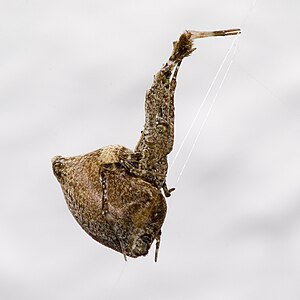Feather foot spiders
| Feather foot spiders | ||||||||||||
|---|---|---|---|---|---|---|---|---|---|---|---|---|

|
||||||||||||
| Systematics | ||||||||||||
|
||||||||||||
| Scientific name | ||||||||||||
| Uloborus | ||||||||||||
| Latreille , 1806 |
The feather foot spiders ( Uloborus ) a genus from the family of the curling wheel web spiders (Uloboridae) and comprise 76 species . (As of July 2016)
They are mainly distributed in the tropics and subtropics and only occur in North America and Europe with a few species in the temperate zones .
description
The chelicerae of the cribellate feather foot spiders are moderately robust, but they lack venom glands - a condition which is almost unknown in other spiders and which requires that the spiral of the orb web and the chelicerae alone are sufficient to kill the prey. The long front pair of legs is often curved. In many species, the legs are provided with tufts of feathery hair. The abdomen is often studded with humps and decorated with brush-like tufts of hair, often pale white, speckled, striped or monochrome black color variants. The eight individual eyes are small; Feather foot spiders essentially have to rely on their other senses.
Way of life
The feather-foot spiders weave their relatively small nets with a diameter of 10 to 18 centimeters in damp, shady places near the ground - on small shrubs and in the undergrowth on dead branches, in hollowed-out tree stumps or on rocks. The horizontally arranged wheel nets, which are always similar, consist of ground threads, radii, a dry auxiliary spiral (scaffolding threads) and the concentric catch spiral made of catch threads. They are built on the same principle as the mostly vertical webs of orb web spiders , without being related to them. They are composed of the same elements as the orb nets of the orb web spiders: basic threads, radii, dry auxiliary spiral (framework) and the concentric catch spiral. In addition to the different prey spectrum due to the orientation, the catch threads also differ significantly: While most orb web spiders are ecribellate spiders and produce threads with droplets of glue, the catch threads of feather foot spiders are made of catch wool . Often, however, the network is made very asymmetrical, especially during the breeding season.
species
The World Spider Catalog currently lists 76 species with 8 subspecies for feather foot spiders. (As of July 2016)
- Uloborus albescens O. Pickard-Cambridge , 1885
- Uloborus albofasciatus Chrysanthus , 1967
- Uloborus albolineatus Mello-Leitão , 1941
- Uloborus ater Mello-Leitão , 1917
- Uloborus aureus Vinson , 1863
- Uloborus barbipes L. Koch , 1872
- Uloborus berlandi Roewer , 1951
- Uloborus biconicus Yin & Hu , 2012
- Uloborus bigibbosus Simon , 1905
- Uloborus bispiralis Opell , 1982
- Uloborus campestratus Simon , 1893
- Uloborus canescens C. L. Koch , 1844
- Uloborus canus MacLeay , 1827
- Uloborus cellarius Yin & Yan , 2012
- Uloborus chinmoyiae Biswas & Raychaudhuri , 2013
- Uloborus conus Opell , 1982
- Uloborus crucifaciens Hingston , 1927
- Uloborus cubicus (Thorell , 1898)
- Uloborus danolius Tikader , 1969
- Uloborus diversus Marx , 1898
- Uloborus eberhardi Opell , 1981
- Uloborus elongatus Opell , 1982
- Uloborus emarginatus Kulczyński , 1908
- Uloborus ferokus Bradoo , 1979
- Uloborus filidentatus Hingston , 1932
- Uloborus filifaciens Hingston , 1927
- Uloborus filinodatus Hingston , 1932
- Uloborus formosanus Yoshida , 2012
- Uloborus formosus Marx , 1898
- Uloborus furunculus Simon , 1906
- Uloborus gilvus (Blackwall , 1870)
- Uloborus glomosus (Walckenaer , 1841)
- Uloborus guangxiensis Zhu, Sha & Chen , 1989
-
Uloborus humeralis Hasselt , 1882
- Uloborus humeralis humeralis Hasselt , 1882
- Uloborus humeralis marginatus Kulczyński , 1908
- Uloborus inaequalis Kulczyński , 1908
- Uloborus jabalpurensis Bhandari & Gajbe , 2001
- Uloborus jarrei Berland & Millot , 1940
- Uloborus kerevatensis Opell , 1991
- Uloborus khasiensis Tikader , 1969
- Uloborus krishnae Tikader , 1970
- Uloborus leucosagma Thorell , 1895
- Uloborus limbatus Thorell , 1895
- Uloborus llastay Grismado , 2002
- Uloborus lugubris (Thorell , 1895)
- Uloborus metae Opell , 1981
- Uloborus minutus Mello-Leitão , 1915
- Uloborus modestus Thorell , 1891
- Uloborus montifer Marples , 1955
- Uloborus niger Mello-Leitão , 1917
- Uloborus oculatus Kulczyński , 1908
- Uloborus parvulus Schmidt , 1976
- Uloborus penicillatoides Xie, Peng, Zhang, Gong & Kim , 1997
- Uloborus pictus Thorell , 1898
- Uloborus pinnipes Thorell , 1877
- Uloborus planipedius Simon , 1896
-
Uloborus plumipes Lucas , 1846
- Uloborus plumipes plumipes Lucas , 1846
- Uloborus plumipes javanus Kulczyński , 1908
- Uloborus plumosus Schmidt , 1956
- Uloborus pseudacanthus Franganillo , 1910
- Uloborus pteropus (Thorell , 1887)
- Uloborus rufus Schmidt & Krause , 1995
- Uloborus scutifaciens Hingston , 1927
- Uloborus segregatus Gertsch , 1936
- Uloborus sexfasciatus Simon , 1893
- Uloborus spelaeus Bristowe , 1952
- Uloborus strandi (Caporiacco , 1940)
- Uloborus tenuissimus L. Koch , 1872
- Uloborus tetramaculatus Mello-Leitão , 1940
- Uloborus trifasciatus Thorell , 1890
- Uloborus trilineatus Keyserling , 1883
- Uloborus umboniger Kulczyński , 1908
-
Uloborus undulatus Thorell , 1878
- Uloborus undulatus indicus Kulczyński , 1908
- Uloborus undulatus obscurior Kulczyński , 1908
- Uloborus undulatus pallidior Kulczyński , 1908
- Uloborus undulatus undulatus Thorell , 1878
- Uloborus vanillarum Vinson , 1863
- Uloborus velutinus Butler , 1882
- Uloborus villosus Keyserling , 1881
- Uloborus viridimicans Simon , 1893
- Uloborus walckenaerius Latreille , 1806
Web links
Uloborus in the World Spider Catalog
literature
- Willis John Gertsch : American Spiders. 2nd edition. Van Nostrand Reinhold, New York 1979, ISBN 0-442-22649-7 .
- Wolfgang Nentwig, Theo Blick, Daniel Gloor, Ambros Hänggi, Christian Kropf (eds.): Spinnen Europa. 1991.
Individual evidence
- ↑ a b Natural History Museum of the Burgergemeinde Bern: World Spider Catalog Version 17.0 - Uloborus . Retrieved July 14, 2016.